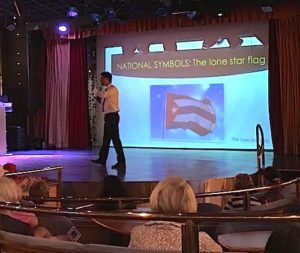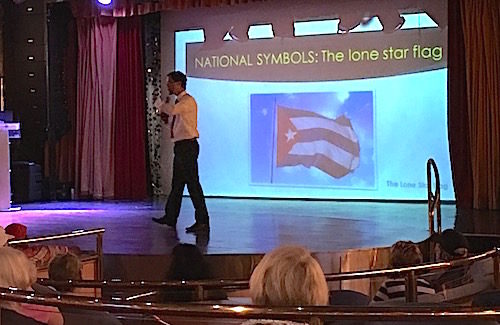Learning about Cuban flag, anthem and coat of arms
 Walk by a Cuban school on an early weekday morning and you’ll probably hear the Cuban National Anthem being sung by the students, including an additional “dun tada dun” at the end.
Walk by a Cuban school on an early weekday morning and you’ll probably hear the Cuban National Anthem being sung by the students, including an additional “dun tada dun” at the end.
“That’s just how we end the song,” Dr. Jorge Arocha said, giving a demonstration.
“I can’t sing,” he said with a laugh. “But I’ll try to show you how it goes.”
A highlight of my People to People cruise has been the programs presented by Arocha in the Celestyal Crystal’s comfortable theater. A professor at the University of Havana, Arocha is well versed in Cuba’s background and culture.
He also speaks excellent English and has a wonderful sense of humor. What he tells us often comes from personal experience because Arocha obviously loves his homeland despite Cuba’s “It’s complicated” history.
On this particular day, Arocha is talking about Cuba’s national anthem, flag and coat of arms. While the words of the anthem were displayed on a large screen, Arocha sang along.
Named El Himno de Bayamo (The Bayamo Anthem), the song was first performed during the Battle of Bayamo in 1868. A solder in the battle, poet Perucho Figueredo, wrote and composed the song.
When Cuban forces overcame the Spanish in the battle, the jubilant people asked Figueredo to compose some words for a melody he had already created. The story goes that Figueredo wrote the lyrics for the anthem while he was still astride his horse.
Only two years later, Figueredo was captured and executed by the Spaniards. Just before the firing squad took his life, Figueredo is said to have shouted this line from his anthem – “Morir por la Patria es vivir” (For to die for the motherland is to live.)
Officially adopted as the national anthem in 1901, El Himno de Bayamo was said to be a favorite of Fidel Castro who often had it played at his public speeches and events. These are the two stanzas:
Run to battle, people of Bayamo!
For the motherland looks proudly to you;
Do not fear a glorious death,
For to die for the motherland is to live.
Living in chains is to live
Mired in shame and disgrace,
Hear the sound of the bugle;
Run, brave ones, to battle
The Cuban flag is red, white and blue with a star. Same basics as the American flag but differently arranged. In the mid 1800s, many people wanted to liberate Cuba from Spain and unite it with America. Could be part of the reason for Cuba’s choice of same colors and star.
The Cuban flag was created in 1849 by Narciso Lopez who used it the following year in his failed attempt to liberate Cuba from Spanish rule.
In 1850, the flag was hoisted in the coastal town of Cardenas after the city was won by Cuban rebels. After the United States seized Cuba from Spain during the Spanish-American War, the American flag flew from Jan. 1, 1899, until independence was granted. On May 20, 1902, the Cuban national flag waved as a symbol of independence and sovereignty.
The three blue strips refer to the three old divisions of the island, Arocha said. The two white stripes represent the strength and purity of the struggle for independence.
“The red symbolizes the blood shed by our heroes in the fight for independence,” he said, adding that the five-sided star inside the red triangle is a symbol of freedom.
The Cuban Coat of Arms consists of a shield, a wreath and a Phrygian cap at the top which represents liberty. Created by Miguel Teurbe Tolon in 1906, the shield is divided into three sections.
“The key between two rocks represent Cuba’s key position between the two Americas,” Arocha said. The rising sun is a symbol of a new nation.
The lower right of the shield has a mountain and palm tree to represent the beauty of the Cuban landscape.
Photo and story by Jackie Sheckler Finch















View Recent Comments